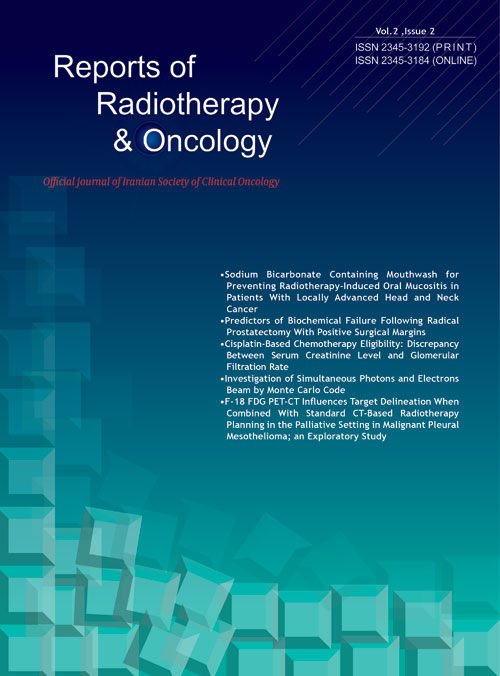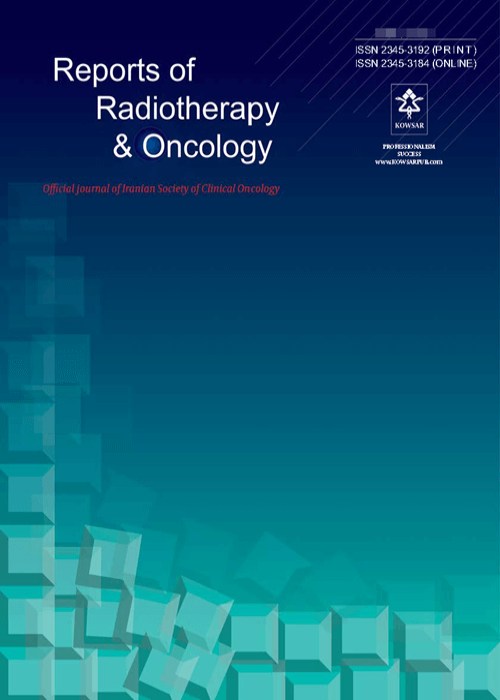فهرست مطالب

Reports of Radiotherapy and Oncology
Volume:2 Issue: 1, Mar 2015
- تاریخ انتشار: 1394/06/27
- تعداد عناوین: 8
-
-
Page 1BackgroundGene therapy relies on the delivery of foreign DNA into cells. More than 50% of all reported clinical trials for gene therapy are for cancer.ObjectivesTo test the tolerability, safety, and recommended phase II dose of Allvec-1, a highly selective gene therapy vector, after systemic administration in patients with advanced stage IV solid tumor malignancies. Patients andMethodsA phase I trial evaluated escalating doses of Allvec-1, administered 3 times weekly for 8 weeks in 6 patients with gastric, breast, esophageal, non-small cell lung cancer (NSCLC), and leiomyosarcoma. Clinical lab parameters, blood pressure, pulse and patients’ own-reported adverse events were used for evaluation of safety. The maximum dose was set based on the first sign of any minor side effect to be likely related to Allvec-1. Tumor imaging techniques were applied before and after Allvec-1 treatment for any tumor response. No further concomitant anti-tumor treatment was admitted during the study period.ResultsSix patients [median age, 50.5 years (range, 23-66), they were heavily pretreated; received Allvec-1 starting at a dose of 1.25 × 1010 and increasing to the final dose of 2 × 1011 thrice weekly. During the study period 3 patients have received 24, one patient 21, one patient 14, and one patient 13 intravenous (I.V) injections, respectively. Treatment-related adverse events were nausea (1 out of 6) and increase of body temperature (38°C, 2 out of 6). These side effects were minor and lasted only up to 30 minutes, and disappeared after repeated dosing. The increase of body temperature occurred 24 to 48 hours after the treatments and was observed only during the second week. No other side effects were reported. All clinical lab and vital functions remained unaffected. An increase of body weight and an improvement of general condition could be observed in 4 out of 6 patients. One of these patients showed stable disease until the end of 4 weeks surveillance period. A partial response was seen in 1 out of 6 patients. Four patients died within one month after termination of the treatment due to the progressive dieses.ConclusionsAllvec-1, as the first gene therapy vector for systemic administration, was tolerated without any side effects. Dose-limiting toxicities were not observed in this study. Therefore, higher doses can be recommended in phase II trials. Despite extensive prior treatment and final stage of all patients a partial response and stable disease could be reached during the treatment period. It could be expected that a treatment beyond 8 weeks, even in those terminally ill patients, might increase the life expectancy without any side-effects. Therefore, additional clinical trials are well warranted in defining the role of Allvec-1 in treatment of cancer.Keywords: Gene Therapy, Solid Tumors, Genetic Vectors
-
Page 7BackgroundColorectal cancer globally affects more than 1 million people every year. It is more common in men and it is the second most common cause of cancer mortality. Optimal treatment of colorectal cancer is a multidisciplinary approach which can be included of surgery, medical oncology, and radiation therapy.ObjectivesThe aim of this study was evaluation of relationship between testicular dose and hormonal changes after radiotherapy in male patients with rectal cancer. Patients andMethodsIn this study 25 patients with rectal cancer were enrolled. The serum levels of luteinize hormone (LH), follicle stimulating hormone (FSH), and testosterone (T) before and 3 - 6 weeks after chemoradiotherapy were compared and testicular dose was determined using a 3-dimension treatment planning system and relationship between hormonal changes and testicular dose was assessed.Results25 patients with rectal cancer with mean (± SD) age of 56.08 (± 14.30) years were evaluated. The mean (± SD) testes dose was 2.35 (± 2.32) Gy that was 6.09% of total dose. The levels of FSH and LH significantly increased (P = 0.001), however, the level of testosterone non -significantly decreased after 3 - 6 weeks of radiation therapy (P = 0.79). No significant correlation was found between testes dose and sex hormones change (LH, P = 0.33; FSH, P = 0.16; testosterone, P = 0.95). Furthermore the testes dose did not correlate with the lower border of treatment field (P = 0.26), total given dose to the patients (P = 0.81) and tumor location (P = 0.09).ConclusionsThe testes dose in this study was 6.09% of total dose. Radiotherapy of rectal cancer causes damage to the testis, as shown by increased levels of gonadotropins after radiotherapy. The radiation therapy significantly increased LH, FSH and non-significantly decreased testosterone level in patients with rectal cancer. No correlation could be found between changes of hormones and doses to the testis, probably due to the low number of evaluated patients. Larger studies are needed to establish the correlation between testicular radiation dose and hormonal changes in this group of patients.Keywords: Radiotherapy, Rectal Cancer, Colorectal Cancer
-
Page 11Background
There are miscellaneous methods of boost field determination with different levels of accuracy. One of the important parameters in boost field planning is the tumor bed depth, as it is important for determining electron energy.
ObjectivesThe purpose of present research was the determination of ultrasound accuracy to estimate the appropriate depth for the tumor bed. Patients and
MethodsPatients who were undergone breast conservative surgery with placing of 5 clips in the tumor bed (lower, upper, medial, lateral, and posterior) were included. The depth and location of the tumor bed were determined using ultrasonography. The optimum field boost was planned with an appropriate 2.5 cm margin. After putting the marker on the field boost, the CT simulation was done and then the obtained depth of the ultrasound report and that of the CT scan-clips were compared.
ResultsTwenty five patients were included. The average depth reported by the ultrasound was about 18 mm ± 3 mm (range 10-26 mm), and the average obtained from the CT scan-clips was about 48 mm ± 13 mm (range 24-80 mm), (P Value = 0.001). In almost all cases, the depth obtained from the ultrasound was less than that obtained from the CT scan- clips.
ConclusionsUltrasound is not an accurate method to determine the appropriate depth and field for determination of breast field boost. Thus, it is better not to use ultrasound to estimate the tumor cavity depth; the CT scan images with surgical clips should be used instead.
Keywords: Breast Cancer, Radiotherapy, Tumor -
Page 15BackgroundThere is still no consensus regarding the optimum treatment of chemotherapy-induced oral mucositis and its management is still mainly supportive. Vitamin E has been shown to be effective in reducing the symptoms of oral mucositis.ObjectivesAim of this study was to assess the efficacy of prophylactic systemic and topical vitamin E in reducing the signs and symptoms of oral mucositis in patients receiving chemotherapy. Patients andMethodsWe conducted a placebo-controlled randomized clinical trial among 76 patients with a hematologic malignancy treated with chemotherapy. Patients were randomly assigned into three groups: supplementation with vitamin E paste (group 1) and 200 mg/d vitamin E pills (group 2). Group 3 received placebo paste, identical in appearance and taste to the vit E paste, but consisting of the vehicle only. Patients were advised to use the administered medication from two days before each cycle of chemotherapy till at least 20 days after completion of each cycle. Oral exam was performed 10-14 days after each cycle of chemotherapy.ResultsPatients in group 2 and 3 did not show any difference in degree of mucositis or severity of pain. However, after the second cycle, patients who were treated with topical vitamin E showed significantly less oral pain, and had fewer cases of severe mucositis compared to groups 2 and 3.ConclusionsTopical vitamin E could be beneficial in reducing the severity of oral mucositis, but no therapeutic gain would be achieved by using systemic vitamin E in this regard.Keywords: Vitamin E Chemotherapy_Oral Mucositis
-
Page 19BackgroundMalnutrition is common in patients with cancer and in many cases can result in shortened survival rate. More than 20% of cancer mortality can be attributed to the effects of malnutrition, rather than malignancy itself. Malnutrition results in poor response to treatment, increased length of hospital stay, immunodeficiency, reduced quality of life, and increased health care costs in patients with cancer.ObjectivesThe aim of this study was to assess the nutritional status of patients with gastrointestinal cancer during chemotherapy. Patients andMethodsIn this study, 92 patients over the age of 18 who were referred to Valie-e-Asr hospital of Zanjan (since Apr, 2011 to Dec, 2011) were selected. Nutritional status of patients during 3 cycles of chemotherapy was assessed by a questionnaire. The obtained data were statistically analyzed by ANOVA, using SPSS 16.0.ResultsThere was a significant relationship between duration of treatment and the average of mid arm circumference (MAC) and body mass index (BMI). BMI can be considered as an anthropometric index which can be used to alarm the physicians about nutrition problems of the patient.ConclusionsAt the end of treatment, patients who survived had better nutritional statuses compared to the ones who passed away. During chemotherapy, malnutrition got worse in patients with metastatic esophageal cancer. Our findings show that patients with moderate or severe malnutrition are in the critical need to improve their malnutrition status.Keywords: Gastrointestinal Cancer, Malnutrition, Chemotherapy
-
Page 27IntroductionPolymorphous low-grade adenocarcinoma (PLGA) occurs mostly in minor salivary glands, and there are only a few reports of major salivary gland origin.Case PresentationWe herein report a case of de novo PLGA arising in a submandibular gland in an 88 years-old woman. On examination, a large firm and non-tender mass was palpable in the submandibular region.ConclusionsNeither lymphadenopathy nor enlargement of any other salivary glands was present. CT showed a well-defined mass with irregular enhancement in the submandibular gland.Keywords: Adenocarcinoma, Submandibular Gland, Woman
-
Page 31IntroductionCutaneous B-Cell lymphoma can be associated with clinically significant nail alterations, the presentation of which can be unusual and misleading. To date, only a few reports have demonstrated direct specific tumor infiltration of the nail bed with lymphoma, while there is much less information about infiltration of nail bed with diffuse large B-cell lymphoma.Case PresentationWe describe the case of a 74 years old man presenting with nail bed ulceration who developed clinically significant nail shape alterations. Light microscopy studies demonstrated the presence of a specific lymphocyte infiltrate within the nail bed. The IHC analysis demonstrated diffuse large B cell lymphoma (DLBCL).ConclusionsSpecific nail involvement should be recognized and considered in all patients with cutaneous B-cell lymphomas specially when there is refractory to conventional treatment.Keywords: Diffuse, Large B, Cell, Lymphoma (DLBCL), Lymphoma, Radiotherapy
-
Page 35Context: Chemoradiation provides a survival advantage as well as increased rate of organ preservation compared with radiation alone in locally advanced head and neck squamous cell carcinoma (LAHNSCC). Evidence Acquisition: Combined modality protocols can be used in 3 forms: a) induction chemotherapy or neoadjuvant therapy before definitive surgery or radiotherapy, b) Concurrent chemo- radiotherapy, and c) sequential therapy consisting of induction chemotherapy followed by concurrent chemo radiation.ResultsDespite an improvement in organ preservation, induction treatment has no impact on survival. Ongoing phase III trials comparing sequential therapy with concurrent chemoradiation may establish which of these two approaches is superior.ConclusionsUntil those trials have been completed, Taxane- based sequentional therapy can be a reasonable alternative to concurrent chemo radiotherapy in the patients with locally advanced disease.Keywords: Radiotherapy, Head, Neck Neoplasms, Chemotherapy


